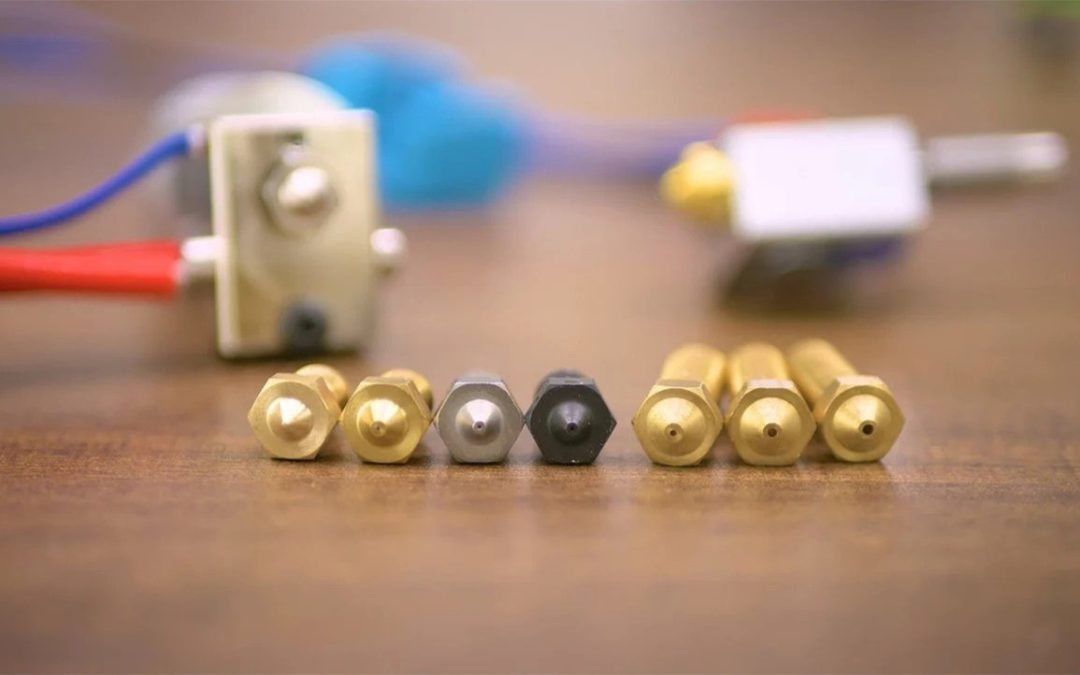A big question for new and current users 3d printers is what are the differences between the types of nozzles and what nozzle is best for what materials?
When classifying nozzles we observe 2 main characteristics: The Nozzle Material and The Output diameter.
Output diameter
Within the diameter, there is a wide range of measures ranging from 0.20 mm (although there are already some 0.15 mm and 0.10 mm nozzles) to 1.2 mm.
Material
Brass nozzles:
This is the most common nozzle material, because it has high thermal conductivity and stability, in addition to its ease of machining and economic price. Its main drawback is the fast wear to abrasive materials that contain fibers.
Brass nozzles can deteriorate externally from every bump or scrape that might happen during the 3D printing process. Even though this is not immediately noticeable, the wear and tear builds up slowly over time, which can truly compromise important external dimensions of the nozzle.
Brass nozzle Stats:
- Maximum temperature: 300 °C
- Best used with: Non-abrasive filaments such as PLA, ABS, PETG, Nylon, and TPE, TPU
Stainless Steel
Stainless steel is another popular material used in nozzles, as it provides a slightly better wear-resistance than its brass counterparts. They also prevent, to some degree, melted plastic from getting stuck to its surfaces, keeping it tidier. Moreover, these nozzles don’t contaminate the print with lead, which usually happens with brass nozzles. Stainless steel nozzles are therefore theoretically suitable for food-grade materials.
Stainless steel allows for a wider variety of filaments to be used but is still not recommended for heavy usage of abrasive materials. It’s also less thermally conductive in comparison to brass.
- Maximum temperature: 500 °C
- Best used with: Non-abrasive filaments and light use of abrasive materials such as NylonX, carbon fiber, glow-in-the-dark, metal-filled, wood-filled, and ceramic-filled filaments.
Hardened steel nozzles:
To solve this problem of rapid wear of the brass nozzles, the hardened steel nozzles appear, being up to 10 times more wear-resistant and maintaining the same qualities. As for disadvantages, these nozzles have a lower heat transmission and, since they contain lead, they are not recommended to make pieces that are in contact with the skin or food.
Being such a hard metal, the bore machining of these nozzles is also problematic. Some claim that its internal surface is not as smooth as other “softer” materials, possibly leading to less quality printing.
- Maximum temperature: 500 °C
- Best used with: All materials, including heavy use of abrasive materials
Assembled Nozzles
The Olsson Ruby is a special nozzle, manufactured from a brass nozzle with an inlaid tip of ruby. This combination is ideal to have a stable temperature, almost infinite durability, and unparalleled printing precision.
- Maximum temperature: High temperatures, but the exact maximum temperature varies between models
- Best used with: All materials, including heavy use of abrasive materials and engineering plastics such as PEEK and Ultem
Tungsten Carbide Nozzles
Tungsten carbide, not to be confounded with tungsten alloy, which is metal, is the ceramic of choice when it comes to wearing and abrasion resistance. Cutting tools for steel and tool steel are made from tungsten carbide. It is also used extensively in the mining industry as a button insert for crushing rocks.
The high thermal performance of the tungsten carbide keeps the nozzle tip hot, thus allowing faster printing speed without sacrificing the quality.
Tungsten carbide has exceptional wear resistance due to its high hardness. Both the nozzle hole size and height will always stay the same, no matter how long or how hard you use it.
- Maximum temperature: 500 °C
- Best used with: Any material. From printing PLA to carbon fiber reinforced plastics, this nozzle can handle anything. The low friction coating greatly helps with flexible filaments allowing, them to slide through the nozzle. A single nozzle will offer quality prints, wear resistance, and high flow, so there is no need to get a ton of different nozzles when a single one can offer the best of all worlds.

